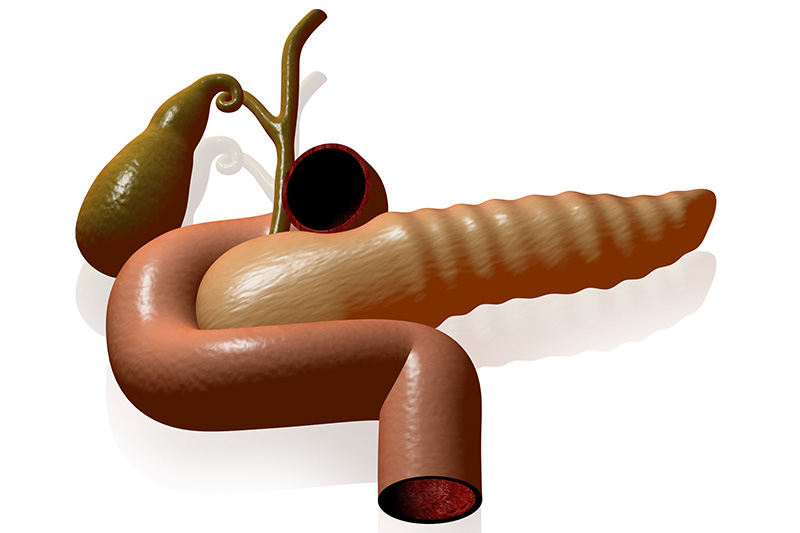Learn more about Pancreatic Cancer with 5 years survival rate of 5%
Pancreatic cancer is said to be the worst of all cancers, as ithas the lowest survival rateamong the 10 most common cancers in Korea, with a 5-year survival rate of about 5%. This is because it is difficult to perceive the symptoms and diagnose the condition early. On top of that, it tends to grow rapidly and metastasize quite easily. By the time it is detected, it will haveprogressed to the extent that it cannot be resected. This is why only 15 to 20% of patients are eligible for surgery.
Pancreas with Both Endocrine and Exocrine Functions
The pancreas is a large digestive gland with an endocrine function of secretinga hormone for regulating carbohydrate metabolismand an exocrine function of secreting pancreatic juice. Glucagon and insulin are secreted from the islets of Langerhans, a special islet-shaped tissue within the pancreas. Glucagon is secreted when the blood sugar level is low, and it increases the glucose concentration by promoting the breakdown of glycogen, a storage form of glucose. Digestive enzymes secreted by the exocrine pancreas include trypsin, which breaks down proteins, amylase, which breaks down carbohydrates, and lipase, which breaks down fat.
Difficulty in Early Detection Due to Absence of Specific Symptoms
Although the exact cause of pancreatic cancer is unknown, smoking is speculated to be the most common cause. This is because 20 to 30% of all pancreatic cancer cases are associated with smoking, and the risk of developing pancreatic cancer is 2 to 5 times higher for smokers compared to non-smokers. What is also interesting is that the risk is also proportional to the amount of smoking. Aside from smoking, there is a correlation between pancreatic cancer and a long-term history of diabetes, chronic pancreatitis, and a high-fat diet. Family history, such as having one or more immediate family members who have developed pancreatic cancer before the age of 50 and having two or more such patients in the family, irrespective of the age of onset, is also important. Upon the onset of pancreatic cancer, symptoms that can occur include loss of appetite and bloating, and the affected individual may also complain of indigestion and pain in the upper abdomen. It may also be accompanied by pain of unknown cause, weight loss, and lethargy. Also, when the cancer is located in the head of the pancreas, it will likely block the bile duct passing through it and cause jaundice. The problem is that pancreatic cancer is usually not suspected or is difficult to detect at an early stage because the symptoms are similar to those of other digestive diseases.
For diagnosis, abdominal ultrasound is performed, but because the pancreas is located deep underneath other organs, such as the stomach and large intestine, it is difficult to observe. Moreover, the pancreas is difficult to identify in patients whose intestines are full of gas or who have a big belly. Aside from abdominal ultrasound, radiographic examinations, such as abdominal computed tomography (CT) and abdominal magnetic resonance imaging (MRI), are mainly performed. Endoscopic retrograde cholangiopancreatography (ERCP) and endoscopic ultrasound are also helpful in making a proper diagnosis. Although serum carbohydrate antigen (CA 19-9) is the most widely used tumor marker for pancreatic cancer, other cancers can also increase CA 19-9 levels, so it is difficult to conclude that it is pancreatic cancer based on the CA19-9 levels alone.
Metastasis, an Important Consideration in Deciding the Treatment Method
If the cancer has not spread to other organs and is confined to the pancreas, the pancreas will be resected partially, fully, or with the surrounding tissue. Cancer in the head of the pancreas calls for Whipple’s operation, during which the head of the pancreas, a part of the small intestine, the lower part of the stomach, the gallbladder and the bile duct are removed, and the remaining pancreas and the bile duct are attached to the upper part of the stomach. Pylorus-preserving pancreaticoduodenectomy is similar to Whipple's surgery, but it preserves the stomach and thus is more commonly performed these days. If the cancer has metastasized and surgery is difficult, chemotherapy is recommended to relieve symptoms and prolong the patient’s life, but it reduces red blood cells, white blood cells, and bone marrow cells and may affect other digestive organs. Also, in the case of locally advanced pancreatic cancer that has not metastasized but invaded nearby arteries and veins, chemotherapy is carried out first, and surgery is performed after the size of the pancreatic cancer is reduced.

The Key to Prevention: Quit Smoking!
The key to preventing pancreatic cancer is to either not start smoking or to quit smoking. It is advisable to avoid secondary smoking as well. Maintaining an appropriate weight through diet and exercise is recommended, and those suffering from diabetes or chronic pancreatitis should receive ongoing treatment. Pancreatic cancer patients are likely to suffer from reduced appetite due to indigestion and may have difficulty ingesting food due to nausea and vomiting occurring as side effects of treatment. Therefore, it is recommended to reduce fat intake and eat soft, high-calorie foods that are easy to digest in small amounts at frequent intervals. Mixing brown rice or glutinous rice with regular riceis great for digestion, while selenium, which is found in abundance in broccoli, is known to have an excellent anticancer effect. Meanwhile, flavonols in spinach, apple, and onion reduce the risk of pancreatic cancer, and lycopene found in tomatoes is a strong antioxidant. Last but not least, it is recommended that you drink 1.5 to 2 liters of water a day.
Source: Health Column of Daejeon Eulji Medical Center, Eulji University| Prof. Kim Ji-hoon, M.D.






 Specialized Medical Service
Specialized Medical Service
 Bio Technology
Bio Technology
 Health & Wellness
Health & Wellness
 City & Culture
City & Culture
 Hot Issue
Hot Issue
 Interview With
Interview With
 Medical Technology
Medical Technology
 City & Culture
City & Culture
 Food & Travel
Food & Travel
 Health & Wellness
Health & Wellness
 Hot Issue
Hot Issue